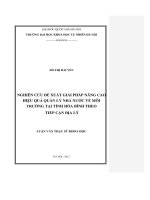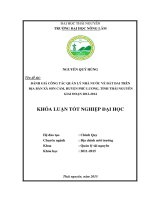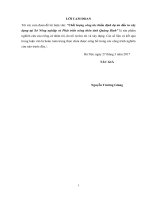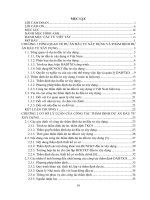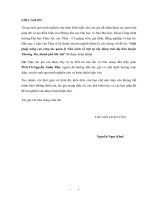Đề xuất giải pháp nâng cao công tác quản lý nhà nước về việc làm cho lao động nông thôn tại huyện phú bình tỉnh thái nguyên
Bạn đang xem bản rút gọn của tài liệu. Xem và tải ngay bản đầy đủ của tài liệu tại đây (3.67 MB, 92 trang )
DECLARATION
I hereby declare that is the research work by myself under the supervisions of Assoc.
Prof. Dr. Tran Thanh Tung and Dr. Nguyen Quang Chien. The results and conclusions
of the thesis are fidelity, which are not copied from any sources and any forms. The
reference documents relevant sources, the thesis has cited and recorded as prescribed.
The results of my thesis have not been published by me to any courses or any awards.
Ha Noi,
January 2016
Vu Duy Toan
i
ACKNOWLEDGEMENTS
I would like to thank to my daily supervisors Dr. Nguyen Quang Chien and
Assoc.prof.Dr. Tran Thanh Tung for sharing their knowledge, providing their useful
feedback, guidance, the time invested in me, advice and discussion we had during my
thesis work.
Furthermore, I would like to thank to my family, showing their interest and
unconditional support.
ii
TABLE OF CONTENTS
DECLARATION ............................................................................................................i
ACKNOWLEDGEMENTS ......................................................................................... ii
TABLE OF CONTENTS ............................................................................................ iii
LIST OF FIGURES ....................................................................................................... v
LIST OF TABLES ...................................................................................................... vii
ACKNOWLEDGEMENTS ...................................................................................... viii
INTRODUCTION ........................................................................................................ix
1. Motivation .................................................................................................................. x
2. Research Scope .......................................................................................................... x
3. Research objective ..................................................................................................... x
4. Research content ....................................................................................................... x
5. Literature review ......................................................................................................xi
6. Research methods................................................................................................... xii
CHAPTER
I.
OVERVIEW
OF
SHORELINE
EVOLUTION
AND
SIMULATION USING ONE-LINE MODELS .......................................................... 1
1.1.Some issues worth considering in coastline evolution study ................................ 1
1.2. Process study shoreline changes in the world and current research trends .......... 1
1.3. Numerical modeling of coastline evolution .......................................................... 3
1.3.1. Basic Assumption of shoreline change modeling.......................................... 3
1.3.2. Litpack model ................................................................................................ 5
1.3.3. Unibest model ................................................................................................ 6
1.3.4. Genesis model ................................................................................................ 8
1.3.6. Conclusion ................................................................................................... 13
CHAPTER II. ANALYSIS NHA TRANG COASTLINE EVOLUTION .............. 14
2.1. Overview of the study area ................................................................................. 14
2.2. Data for shoreline and beach monitoring ........................................................... 15
2.2.1. Climatology ................................................................................................. 15
iii
2.2.2. Hydrodynamics ........................................................................................... 18
2.2.3. Geology and Geomorphology ..................................................................... 19
2.2.4.
Wave characteristics .............................................................................. 19
2.2.5.
Sediment Transport Regime in Nha Trang ............................................ 20
2.3. Analysis Nha Trang coastline evolution ............................................................ 22
2.4. Conclusion .......................................................................................................... 24
CHAPTER 3. APPLY OF ONE-LINE MODEL TO STUDY NHA TRANG
COASTLINE EVOLUTION ...................................................................................... 25
3.1. SWAN MODEL ................................................................................................. 25
3.1.1. Basic theory of SWAN model ..................................................................... 25
3.1.2. SWAN model setup ..................................................................................... 30
3.2. GENESIS MODEL ............................................................................................ 42
3.2.1. Basic theory of Genesis model .................................................................... 42
3.2.2. Setup Genesis model ................................................................................... 47
CHAPTER 4. PROPOSE ORIENTED SOLUTIONS TO STABILIZE NHA
TRANG BEACH ......................................................................................................... 56
4.1. Scenarios simulated with protective structure.................................................... 56
4.1.1. Scenarios Nha Trang coastline evolution without protective structure for 1
year, 5 years, 10 years ........................................................................................... 56
4.1.2. Scenarios Nha Trang coastline evolution with protective structure for 1
year, 5 years, 10 years ........................................................................................... 58
4.2. Scenarios simulated with beach nourishment .................................................... 61
CONCLUSION ............................................................................................................ 63
REFERENCES ............................................................................................................ 65
APPENDICES ............................................................................................................. 68
iv
LIST OF FIGURES
Figure 1.1. Nha Trang coast (Source: Google earth) .....................................................ix
Figure 1.2. Conceptual framework of Nha Trang Coastline evolution study ............. xiii
Figure 1.3. Input and output file structure of GENESIS ................................................. 8
Figure 1.4. Calculation diagram of Genesis model ....................................................... 10
Figure 2.1. The discharge from Cai River in the year of 2013 as well as the mean
rainfall in Nha Trang in the years 1995 – 2014. ............................................................ 16
Figure 2.2. The variation of the wind magnitude and direction for September during
the years of 2002 – 2011, i.e. during the southwest monsoon. ..................................... 17
Figure 2.3. The variation of the wind magnitude and direction for November during
the years of 2002 – 2011, i.e. during the northeast monsoon. ....................................... 17
Figure 2.4. The tidal level variation in the south of Nha Trang bay in the year of 2013
measured at Institute of Oceanography Tide Station in Nha Trang .............................. 18
Figure 2.5. Wave rose offshore Nha Trang ................................................................... 20
Figure 2.6. Nha Trang shoreline over years from 2003 – 2015 .................................... 23
Figure 3.1. Computational domain of Swan model....................................................... 31
Figure 3.2. Wave height boundary condition for Swan model ..................................... 33
Figure 3.3. Wave period boundary condition for Swan model ..................................... 33
Figure 3.4. Wave direction boundary condition for Swan model ................................. 33
Figure 3.5. The location of two points use for calibration in Swan model ................... 35
Figure 3.6. Wave height of Swan model & Wavewatch III data at Continental shelf
1(109.5, 12.5) (From January to December, 2013) ....................................................... 37
Figure 3.7. Wave Period of Swan model & Wavewatch III data at Continental shelf
1(109.5, 12.5) (From January to December, 2013) ....................................................... 37
Figure 3.8. Wave Period of Swan model & Wavewatch III data at Continental shelf
1(109.5, 12.5) (From January to December, 2013) ....................................................... 38
Figure 3.9. Wave height of Swan model & Wavewatch III data at Continental shelf 2
(109.5, 12.0) (From January to December, 2013) ......................................................... 38
Figure 3.10. Wave period of Swan model & Wavewatch III data at Continental shelf 2
(109.5, 12.0) (From January to December, 2013) ......................................................... 39
v
Figure 3.11. Wave Direction of Swan model & Wavewatch III data at Continental
shelf 2 (109.5, 12.0) (From January to December, 2013) ............................................. 39
Figure 3.12. Wave height of Swan model & Wavewatch III data at Continental shelf 1
(109.5, 12.5) (June to August, 2014)............................................................................. 40
Figure 3.13. Wave period of Swan model & Wavewatch III data at Continental shelf 1
(109.5, 12.5) (From June to August, 2014) ................................................................... 40
Figure 3.14. Wave height of Swan model & Wavewatch III data at Continental shelf 2
(109.5, 12.0) (From June to August, 2014) ................................................................... 41
Figure 3.15. Wave height of Swan model & Wavewatch III data at Continental shelf 2
(109.5, 12.0) (From June to August, 2014) ................................................................... 41
Figure 3.19. Extract wave data points as boundary conditions for Genesis model ...... 48
Figure 3.21. Wave height for genesis boundary condition ........................................... 50
Figure 3.22. Wave Period for Genesis boundary condition .......................................... 51
Figure 3.23. Wave Direction for Genesis boundary condition ..................................... 51
Figure 3.24. Measured and predicted shoreline positions using different transport
parameters (12/2013) ..................................................................................................... 53
Figure 3.25. Comparison of shoreline in model and measured data for 27/06/2014 .... 55
Figure 4.1. Nha Trang coastline evolution without protective structure over years ..... 56
Figure 4.2. Nha Trang shoreline position over ten years .............................................. 58
Figure 4.4. Result of Scenario with three Breakwaters over 10 years .......................... 59
Figure 4.4. Nha Trang coastline evolution after nourishment over years ..................... 62
vi
LIST OF TABLES
Table 2.1. Statistic storms directly influence to Khanh Hoa Province ......................... 15
Table 3.1. The default setting in SWAN and selection for model setting..................... 32
Table 3.2: Parameters used for model calibration ......................................................... 36
Table 3.3. Root mean square percentage error with different cases for Nha Trang
shoreline......................................................................................................................... 54
Table 4.1. Shoreline change after 1 year without protective structure .......................... 57
Table 4.2. Shoreline change after 5 years without protective structure ........................ 57
Table 4.3. Shoreline change after 10 years without protective structure ...................... 57
Table 4.4. Shoreline change after 1 year after building three breakwaters ................... 60
Table 4.5. Shoreline change after 5 years after building three breakwaters ................. 60
Table 4.6. Shoreline change after 10 years after building three breakwaters ............... 61
vii
ACKNOWLEDGEMENTS
I would like to thank to my daily supervisors Dr. Nguyen Quang Chien and
Assoc.prof.Dr. Tran Thanh Tung for sharing their knowledge, providing their useful
feedback, guidance, the time invested in me, advice and discussion we had during my
thesis work.
Furthermore, I would like to thank to my family, showing their interest and
unconditional support.
viii
INTRODUCTION
Study area
Nha Trang is a coastal city and capital of Khanh Hoa province. The study area is
located at the vicinity of Cai River, the north is Cai River and at the south of study
area is a breakwater of military port.
Nha Trang is one of the most beautiful bays in the world, one of tourist centers,
famous resort in the country and the world with many beautiful landscapes, blue sea,
many of the most typical ecosystems the coral reefs, many beautiful sandy beaches.
With marine tourism criteria at present the world is: Sun, Sea, Sand (3S), the Nha
Trang Bay meets these criteria above. Nha Trang has many beautiful beaches, the
beach along Tran Phu Street with a length of about 7 kilometers is the most famous
beach.
Nowadays the city experiences new possibilities to earn capital as tourists are drawn to
the area. Many people come for the appealing weather, but the long and central located
sandy beach is also making it an attractive place for leisure.
Figure 1.1. Nha Trang coast (Source: Google earth)
ix
1. Motivation
Viet Nam has 3260 km coastline, 89 river mouths and more than 3000 islands. Along
the coastline are 29 provinces and cities. A number of seaports, oil refinery plants,
fishing areas and aquaculture zones greatly contributes to the economic development
of the coastal and estuarine areas.
Beside advantages and huge potential, annually we have to deal with beach erosion,
estuarine deposition and the Government had to invest thousands of billions VND to
consolidate, upgrade sea dykes and to build coastal structure protection.
Coastline evolution process is very complicated, which varies in space and time. The
process is strongly related to nearshore hydrodynamic condition including tidal
circulation, wind wave, wave-induced currents combined with storm surge. Especially
it becomes more and more complicated and stronger due to climate change and sea
level rise. On the other hand, due to the continuity of the longshore sediment transport,
the coastal protection in this region will again cause erosion in other regions.
Therefore, it is necessary to perform coastline evolution prediction based on the
bathymetry, meteorology, nearshore hydrodynamic for coastal zone planning with the
aims of sustainable development and national defense.
2. Research Scope
Nha Trang beach section (300 m at the vicinity of Cai River).
3. Research objective
-
The study aims to estimate Nha Trang coastline evolution using Genesis model.
-
Propose alternative solutions to protect Nha Trang Coast.
4. Research content
- Analysis on the coastline evolution of Nha Trang coast.
- Modelling wave propagation from deep water to shallow water using Swan model.
x
- The rationale and usability of Genesis model, a one-line numerical model, for
coastline evolution and coastal erosion.
- Applying Genesis model to predict shoreline changes for the background scenario
after 1 year, 5 years, and 10 years.
- Proposal of preliminary solutions to protect Nha Trang coast.
- Applying Genesis model to predict shoreline changes with the presence of structure
after 1 year, 5 years, and 10 years.
5. Literature review
Recently, some researches relevant to the coastline evolution and hydrodynamic in the
area of Nha Trang has been performed.
Le Thanh Binh and Duong Hai Thuan, ‘The Shoreline Evolution of the Nha Trang
Beach, Khanh Hoa, Vietnam’, 2015. Binh and Thuan (2015) showed that strong
erosion phenomenon occurred at the area behind the groin during the northeast
monsoon and revealed foot of the embankments along the beach.
Le Thanh Binh and others, ‘Some Preliminary Results on Studying the Shoreline
Evolution of Nha Trang Bay Using Video-Camera’, Binh et al. (2014) indicated that
the monitoring technique on shoreline change in Nha Trang beach is very significant
and it obviously illustrates a good tendency and general picture on seasonal evolution
of shoreline change in Nha Trang beach.
Nguyễn Trung Việt et al., ‘Investigation of Erosion Mechanism on Nha Trang Coast,
Viet Nam’, 2015. Viet et al. (2014) showed that the erosion of the coast in recent year
relating to the degeneration of a river mouth sand spit. In particular, the erosion is
caused by waves which are generated by northeast monsoon resulting in longshore
sediment transport directed from north to south. Moreover, shoreline retreat or
monsoon season were calculated from wind data.
Nguyễn Thành Luân, Nguyễn Hoàng Sơn and Trần Thanh Tùng, ‘Nghiên Cứu Biến
động Vùng Cửa Sông Cái, Nha Trang qua Các Tư Liệu Viễn Thám (giai đoạn 1999 2013)’, 45.5 (2014). Luan et al. (2014) used remote sensing technique to analyze
xi
coastline evolution and indicated that the coastline evolution in this area is due to
certain parameters like wind, wave, seasonal river discharge, and water level.
Nguyễn Trung Việt et al., ‘Seasonal Evolution of Shoreline Changes in Nha Trang
Bay, Vietnam’, 2016. Viet et al. (2016) showed that coastline evolution due to both
human and nature has major effects on the future of tourism development. Moreover,
the beach will be affected by potential increase in the frequency of typhoons.
6. Research methods
- Numerical Modeling:
● Using Swan model to propagate wave from deep water to shallow water.
● The use of Genesis model to predict coastline evolution
- Documentary Analysis: collecting basic data and previous research results about
natural characteristics, hydrodynamic and coastline dynamics of Nha Trang.
xii
Figure 1.2. Conceptual framework of Nha Trang Coastline evolution study
xiii
CHAPTER I. OVERVIEW OF SHORELINE EVOLUTION AND
SIMULATION USING ONE-LINE MODELS
1.1. Some issues worth considering in coastline evolution study
Coastline evolution mainly includes the following issues:
- Coastal deposition, erosion causing coastline change (marine transgression, marine
degradation);
- The process of rising, lowering of local the beach elevation;
- Coastline evolution process under the impact of the coastal and river constructions.
These processes are considered in the whole period from the past, present to future. In
this thesis report, the term evolution refers to the future development of the coastline.
1.2. Process study shoreline changes in the world and current research trends
The breaking waves and surf in the nearshore combining with various horizontal and
vertical patterns of nearshore currents effectively transport beach sediments.
Sometimes this transport result only in a local rearrangement of sand into bars and
troughs or into series of rhythmic embayment cut into the beach. At other times there
are extensive longshore displacements of sediments, possibly moving hundreds of
thousands of cubic meters of sand along the coast each year. Longshore sediment
transport is among the most important nearshore processes that control beach
morphology, and determines in large part whether shores erode, accrete, or remain
stable. An understanding of longshore sediment transport is essential to sound coastal
engineering design practice.
Currents associated with nearshore cell circulation generally act to produce only a
local rearrangement of beach sediments. The rip currents of the circulation can be
important in the cross-shore transports of sand, but there is minimal net displacement
of beach sediment along the coast. More important to the longshore movement of
sediments are wave breaking obliquely to the coast and the longshore currents they
generate, which may flow along an extended length of beach. The resulting movement
of beach sediment along the coast is referred to as littoral transport or longshore
1
sediment transports, whereas the actual volumes of sand involved in the transport are
termed the littoral drift. This longshore movement of beach sediment is of particular
importance in that the transport can either be interrupted by the construction of Jetties
and breakwaters (structures that block all or a portion of the longshore sediment
transport), or can be captured by inlets and submarine canyons. In the case of a jetty,
the result is a buildup of the beach along the up drift side of the structures and erosion
of the beach down drift of the structures. The impacts pose problems to the adjacent
beach communities, as well as threaten the usefulness of the adjacent navigable
waterways.
The littoral transport can also result from the currents generated by alongshore
gradients in breaking wave height, commonly called diffraction currents. This
transport is manifested as a movement of beach sediments toward the structures which
creates these diffraction currents (such as jetties, long groins and headlands). The
result is transport in the “upwave” direction on the downdrift side of the structure.
This, in turn, can create a buildup of sediment on the immediate, downdrift side of the
structure or contribute to the creation of the crenulated-shaped shoreline on the
downdrift side of a headland.
Also in recent times, the World and Asian countries attach great importance to the
study of changes in the estuary and the coast of the Netherlands, the US, UK, Belgium,
Japan, Thailand, Singapore. Concurrent to the research, many construction works on
estuaries and coasts have also been built, which have great effect on the development
of economic and national security of the countries above. Another important topic of
coastal and estuarine research is the prediction of coastal sediment transport, which
has been developed and matured, as represented by research scientists to the United
States, Japan, and the Netherlands.
The main trends in research developments and coast estuaries in the world today are:
• Modernization of the survey means to obtain results which are well
documented, helping to assess the status of being realistic and provide the exact
parameters for the mathematical model.
2
• Improving the mathematical description of the process and methods.
• Carry out field research, in conjunction with laboratory experiments using
hydraulic models.
• Full data warehousing and advanced techniques in data retrieval and processing.
1.3. Numerical modeling of coastline evolution
1.3.1. Basic Assumption of shoreline change modeling
A common observation is that the beach profile maintains an average shape that is
characteristic of the particular coast, apart from times of extreme change as produced
by storms. For example, steep beaches remain steep and gently sloping beaches remain
gentle in a comparative sense and in the long term. Although seasonal changes in wave
climate cause the position of the shoreline to move shoreward and seaward in a
cyclical manner, with corresponding change in shape and average slope of the profile,
the deviation from an average beach slope over the total active profile is relatively
small. Pelnard – Considere (1956) originated a mathematical theory of shoreline
response to wave action under the assumption that the beach profile moves parallel to
itself, i.e., that it translates shoreward and seaward without changing shape in the
course of eroding and accreting. He also by waves obliquely incident to a beach with a
groin installed in a movable-bed physical model.
If the profile shape does not change, any point on it is sufficient to specify the location
of the entire profile with respect to a baseline.
Thus, one contour line can be used to describe change in the beach plan shape and
volume as the beach erodes and accretes. This contour line is conveniently taken as the
readily observed shoreline, and the model is therefore called the “shoreline change” or
“shoreline response” model. Sometimes the terminology “one-line” model, a
shortening of the phrase “one-contour line” model, is used with reference to the single
contour line.
A second geometrical – type assumption is that sand is transported alongshore between
two well – defined limiting elevations on the profile. The shoreward limit is located at
the top of the active berm, and the seaward limit is located where no significant depth
changes occur, the so-called depth of profile closure. Restriction of profile movement
3
between these two limits provides the simplest way to specify the perimeter of beach
cross-sectional area by which changes in volume, leading to shoreline change, can be
computed.
The model also requires predictive expressions for the total longshore sand transport
rate. For open-coast beaches, the transport rate is a function of the breaking wave
height and direction alongshore. Since the transport rate is parameterized in terms of
breaking wave quantities, the detailed structure of the nearshore current pattern does
not directly enter.
Finally, it is assumed that there is a clear long-term trend in shoreline behavior. This
must be the case in order to predict a steady signal of shoreline change from among the
“noise” in the beach system produced by storm, seasonal changes in waves, tidal
fluctuations, and other cyclical and random events. In essence, the assumption of a
clear trend implies that the wave action producing longshore sand transport and
boundary conditions are the major factors controlling long-term beach change. This
assumption is usually well satisfied at engineering projects involving groins, jetties,
and detached breakwaters, which introduce biases in the transport rate.
Standard assumptions of shoreline change modeling are:
- The beach profile shape is constant;
- The shoreward and seaward limits of profile are constant;
- Sand is transported alongshore by the action of breaking waves;
- The detailed structure of the nearshore circulation is ignored;
- There is a long-term trend in shoreline evolution.
Currently, powerful advances in ocean dynamics research, measurement equipment
and calculation technique has allowed us to simulate the process of evolution of the
coastline via computer programs which solve complicated math equations on the
physical phenomena involved. Mathematical model with its special abilities and
increasing popularity has proved to be superior to other research methods through
short implementation time, flexibly in changing simulation scenarios, and high
resolution of results. Of course, due to the limitations in modeling, the exactness of
4
equations and completeness of data input, the solution obtained from the mathematical
model is not absolute accurate, especially in quantitative terms. If the mathematical
model is combined with other methods it is adequate to give us more reliable
forecasting results.
There have been a lot of mathematical models with the software applications that are
well-known scientific institutions in the world of ocean dynamics and over time they
are increasingly complete and advanced. Bruun’s original model (1962) solely account
for the rising water levels due to climate change and tectonic subsidence activities to
predict changes in the coastline. The more modern computer programs such as
GENESIS (US Navy shore CERC combined with Lund university), UNIBEST by the
Institute of Hydraulics Delft - Netherlands, LITPACK by Danish Hydraulic Institute
besides the massive model 2D & 3D has provided users the ability to predict the
morphology of coastal areas such as estuaries MIKE Danish, Dutch Delft 3D, CEDAS
US and other models in the UK, Japan ..., however a full introduction on such models
is outside the scope of this thesis report.
The following section introduces a few powerful mathematical models being widely
used in the world and introduced into Vietnam with the purpose to predict changes in
the coastal zone. The models are: GENESIS, UNIBEST and LITPACK.
1.3.2. Litpack model
a) Introduction of LITPACK model
LITPACK (within the MIKE software suite) is the abbreviation for Littoral Processes
and Coastline Kinetics - Centre of Water and Environment - Danish Hydraulic
Institute (DHI) - is a the software program modeling of non-cohesive sediment
movement under the action of waves and currents, coastal sediment, shoreline changes
and the development of soil on relatively flat coastline.
The sub-modules of the program include:
- LITSTP: for calculating the movement of non-cohesive sediment under the action of
waves and currents;
5
- LITDRIFT: for calculating longshore and coastal sediments;
- LITLINE: for calculating shoreline changes;
- LITPROF: for calculating cross-shore sediment transport;
- LITTREN: for calculating sedimentation in the stream (canals)
b) Module LITLINE – Scope and rationale usability
①- General introduction
LITLINE module is a software program which calculates shoreline changes with the
input wave data is imported by time series. On the other hand, this model was based on
the theory of one line (one-line theory), the cross-sectional area of the coast as surgery
does not change in the course of erosion/accretion. Therefore, only the coast
morphology is described by the shoreline position (coastline position). The one-line
theory is presented in this section is applicable to other software programs (UNIBEST,
GENESIS).
LITLINE has the following applications:
+ Study shoreline changes under the influence of natural factors.
+ Study the shoreline under the influence of the coastal structures.
+ Research shoreline restoration measures by beach nourishment method.
1.3.3. Unibest model
a) General overview:
UNIBEST software (Uniform Beach sediment Transport - sediment movement coasts
are) is built and developed by Hydraulic Institute Delft - Netherlands (WL - Delft
Hydraulics). This software aims to establish a more complete studies and calculated
longshore sediment transport as well as study of relationships morphology between
soil dynamics coast to coast surface shape (shoreline evolution).
UNIBEST process consists of two modules:
6
- UNIBEST-TC: for calculating sediment transport and shoreline developments under
the effect of wave, tidal current and wind;
- UNIBEST-CL+: for calculating shoreline evolution due to differences sediment
transport. Longshore sediment transport is considered the effects of runoff and tidal
waves. UNIBEST-CL + module consists of two sub-modules:
+ A sub module for calculating the longshore sediment transport (the LT module);
+ A sub module for calculating shoreline development (the CL module).
The longshore sediment transport is calculated by module LT. Sediment will be the
input data for the module to calculate CL shoreline changes, which takes into account
the form of coastal structures like: embankment, groins, offshore breakwaters or a
combination of these structures.
b) Sub module UNIBEST LT
This sub module was established to calculate longshore current due to wave and tidal,
thereby calculating longshore transport with any beach profile.
Surf zone dynamics is calculated through wave models which allow modeling of
random waves propagating from deep to shallow water. Longshore and cross-shore
sediment transport are estimated by many different formulas with specific conditions.
Computer programs may require data input regarding the wave field and tidal regime,
and allow calculation of total sediment transport in the year, in season or only in a
storm.
c) Sub-module UNIBEST CL
The CL sub-module is set to calculate shoreline changes due to differences overload
long shore for coastlines near the road are in theory a (single line theory). The
boundary conditions and different initial conditions are included, offering various
situations of coastline evolution.
7
In addition, this model has the ability to calculate the coastal structures with different
types of structures such as: permeable or impermeable groins, seawalls and
embankments, sea dikes, breakwater, estuarine regulation structures, artificial beach
nourishment systems or beach replenishment projects. The effects of wave diffraction
behind structures are also included in the model.
1.3.4. Genesis model
a)
GENESIS
GENESIS is a coastal shoreline and beach topography response model developed by
Hanson and Kraus (1989) for the US Army Corp of Engineers. GENESIS is an
abbreviation for Generalized Model for Simulating Shoreline Change, a software
program to calculate the shoreline changes for a long time at the coast. The study area
of the model in the spatial range (1-100) km and time period (1-100) months.
Figure 1.3. Input and output file structure of GENESIS
GENESIS calculates coastline evolution as a result of the change of longshore
sediment transport over time and space, in which consider including the shoreline
change due to the effects of beach replenishment, due to sediment sources from the
river or coastal structures.
GENESIS is capable of calculating the shoreline changes for natural coasts and in the
case construction works exist. The ability of the model are as follows:
8
- The number and type of buildings arbitrary combination with other forms of work
such as soldering, wave direction dyke, detached breakwater, pier and beach
replenishment projects ashore.
- Structural forms of conventional groins or T-, Y-shaped groins.
- As to the diffracted wave after breakwaters, dikes and embankments nozzle line
direction.
- Calculation for a large domain surrounding the study area.
- Waves input consists of deep water wave height, period and wave direction.
- The data series of different waves.
- Sediment transport generated by obliquely-oriented waves or unevenly distributed
waves heights along the coast.
- Wave overtopping through offshore breakwater.
Besides that, GENESIS has some disadvantages: there are certain restrictions, such as:
- Neglect reflected waves from structures.
- Shoreline Offshore Reach Breakwater. Shore do not untouchable offshore
breakwater.
- Some small limited about distance, shape, structure direction. Small limited number
of distance, shape and orientation of the building.
- Neglect the change of tidal water level.
- Limited of shoreline evolution theory calculation. The main limitations of the
theoretical calculations shoreline changes.
9
Diagram of the model calculations are summarized in Figure 1.4, which notes that the
input wave data can from an external program such as RCPWAVE or directly by
GENESIS.
Offshore
wave
Ho,θo,T
Bathymetry
Dij
Wave simulation model RCPWAVE
Wave
refraction
Hi,θi,T
Shoreline
iti
Breaking
wave
Hbi, θbi, T
Depth
refraction
Di
GENESS
Shoreline evolution
Δyi
Protection structures,
boundary condition
Long shore Sediment
Transport Qi
Figure 1.4. Calculation diagram of Genesis model
1.3.5. Comparision of three one-line models
10
Table 1. Wave in evaluated models
Waves
GENESIS
LITPACK
UNIBEST
Internal wave model
Y
Y
Y
Coupled spectral wave model
Y
N
NA
Wave-current interaction
N
Y
Y
Table 2. Structures in evaluated models
GENESIS
LITPACK
UNIBEST
Breakwaters
Y
Y
Y
Beach fill
Y
Y
Y
Diffracting groin
Y
Y
Y
Nondiffracting groin
Y
NA
Y
Jetties
Y
Y
NA
Seawalls/revetments
Y
Y
Y
T-head groins
Y
NA
NA
Salients/tombolos
Y
Y
Y
Trench
N
Y
N
Detached breakwater transmission
Y
N
NA
Time dependent breakwater transmission
Y
N
NA
Water level dependent wave transmission
Y
N
NA
Wave reflection from structures
N
N
N
Wave diffraction around structures
Y
Y
Y
11
